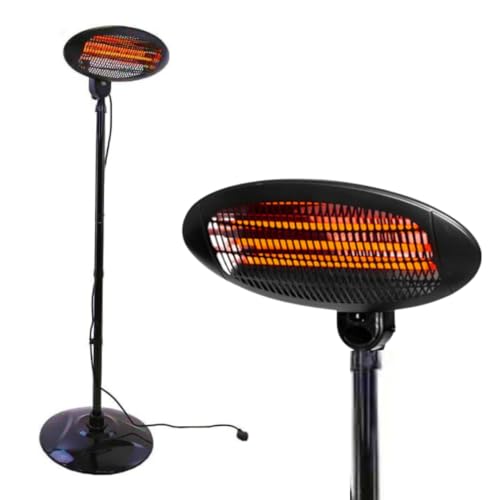The Main Issue With Purchase Patio Heaters, And How You Can Fix It

A Comprehensive Guide to Purchasing Patio Heaters
As outdoor home become increasingly popular, the demand for patio heaters has actually surged. These devices permit homeowners to extend their outdoor satisfaction well into the cooler months. Nevertheless, with a plethora of options offered on the market, picking the best patio heater can seem frustrating. Outdoor Electric Heating Options aims to offer insightful info to help purchasers make notified choices, covering types, functions, aspects to consider, and responses to often asked questions.
Kinds Of Patio Heaters
Patio heaters can be found in numerous designs and styles, catering to different outdoor spaces and preferences. Here's an overview of the most common types:
| Type | Description |
|---|---|
| Gas Patio Heaters | Portable heaters that use lp tanks. They are perfect for areas without electrical power and are easy to walk around. |
| Gas Patio Heaters | Linked directly to a gas line, these heaters are stationary however offer unrestricted heating without the requirement to change tanks. |
| Electric Patio Heaters | Plugged into an electric outlet, they are energy-efficient, simple to utilize, and require very little maintenance. They are available in different heating capabilities. |
| Infrared Patio Heaters | Usage radiant heat innovation to warm specific areas and people instead of the air. This can be especially efficient in windy conditions. |
| Fire Pits | Not conventional patio heaters, fire pits can serve dual functions of heating and supplying a space for roasting marshmallows or enjoying a campfire ambiance. |
Elements to Consider When Purchasing Patio Heaters
When shopping for a patio heater, numerous crucial factors should be considered to ensure a notified decision. Here are key features to evaluate:
Heat Output:
- Patio heaters vary in BTU (British Thermal Units); higher BTUs correspond to more heat.
- For average outdoor areas, think about heaters with an output of 40,000 - 50,000 BTUs for adequate warmth.
Fuel Type:
- Decide in between gas, gas, or electric based upon accessibility and convenience.
- Consider the initial expense and continuous fuel expenditures, as they can differ substantially.
Mobility:
- Determine whether a portable heater or a more permanent service is required based on your outdoor space.
- Portable heaters provide versatility, while gas heaters are more steady but need setup.
Safety Features:
- Look for features like automated shut-off switches, tip-over security, and heat-resistant materials.
- Safety must be a critical concern, specifically in windy areas or around children and family pets.
Design and Aesthetics:
- Consider the design of the heater to ensure it complements your outdoor decoration.
- Choose in between traditional and modern-day styles for a more defined visual.
Ease of Use and Maintenance:
- Assess how simple the heater is to ignite, adjust the heat settings, and tidy after usage.
- Electric models generally need less upkeep compared to lp or natural gas units.
Benefits and drawbacks of Common Patio Heater Types
| Type | Pros | Cons |
|---|---|---|
| Lp Patio Heaters | Portable, high heat output, simple to set up | Requires tank replacement, can be expensive to run |
| Natural Gas Patio Heaters | Limitless heating, low operating expense | Requires expert installation |
| Electric Patio Heaters | Energy effective, essentially maintenance-free | Limited variety, reliant on electrical energy supply |
| Infrared Patio Heaters | Immediate heating, very little wind impact | Typically lower BTU output, specific area coverage |
| Fire Pits | Atmosphere and conversation starter, dual purpose | Requires wood or gas, can be less efficient as a heater |
FAQ about Patio Heaters
1. How much heat does a patio heater supply?
The heat output of patio heaters is measured in BTUs. The majority of outdoor heaters produce in between 30,000 and 50,000 BTUs, adequate to warm a normal outdoor seating location.
2. Can patio heaters be utilized in the rain?
While some patio heaters are developed to be weather-resistant, it is normally a good idea to keep them sheltered throughout rainy conditions to avoid damage and ensure safe operation.
3. Do patio heaters require much maintenance?
Most patio heaters do not need comprehensive upkeep. Regular cleaning and looking for gas leaks in gas or natural gas designs are advised to guarantee durability and security.
4. How long do lp tanks last in patio heaters?
A basic 20-pound gas tank can last in between 10 to 12 hours on high settings, depending on the heater's BTU output.
5. Can I use an electric patio heater indoors?
Electric patio heaters are typically created for outdoor usage; nevertheless, if they are ranked for indoor use, they can be used in well-ventilated areas. Constantly ensure precaution are followed.
In summary, acquiring a patio heater involves thinking about various elements such as heat output, fuel type, mobility, safety functions, and looks. By understanding the different types offered and the benefits and drawbacks associated with each, buyers can confidently choose a patio heater that best fits their outdoor living space. Offered the flexibility and comfort these heaters provide, they can transform any outdoor area into a warm and welcoming retreat for friends and family to collect, even during cooler months. Whether enjoying a cup of tea on a cold evening or hosting a dynamic gathering, a patio heater can make all the distinction.

